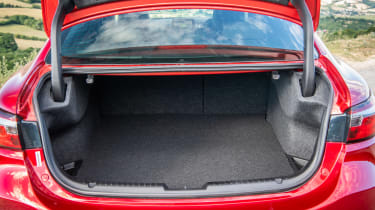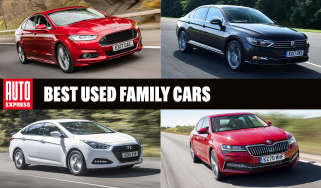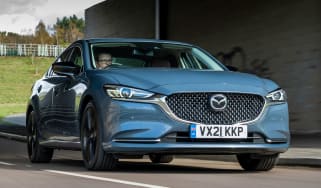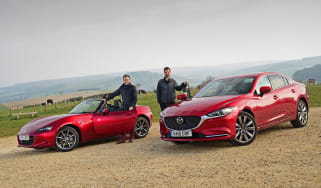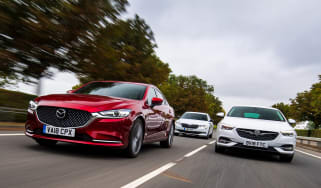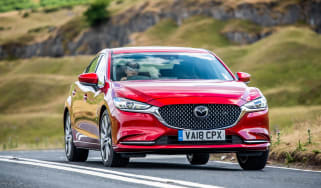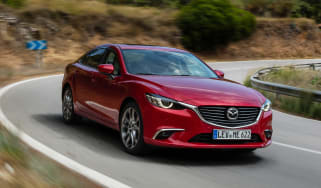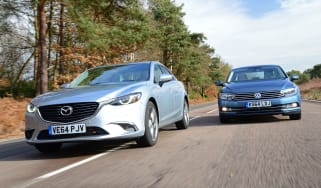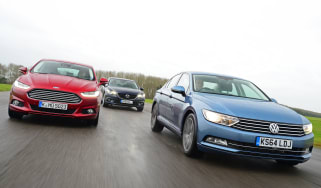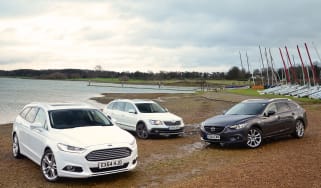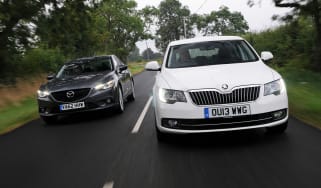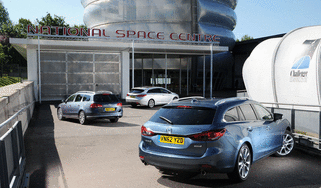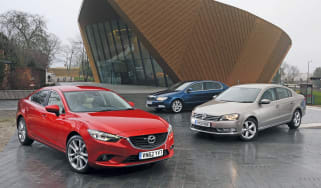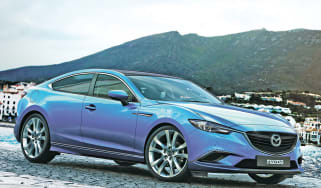Mazda 6 (2012-2022) review
Mazda's large saloon is a strong alternative to the VW Passat or Ford Mondeo thanks to its great handling and generous kit

This is a review of the 2012-2022 Mazda 6. If you are interested in information about a used Mazda 6, please follow the links provided.
The Mazda 6 has long been an Auto Express favourite, winning the Best Family Car category in our 2013 and 2014 New Car Awards. The fact that it's still one of the best in its class after this length of time shows just how good it is.
The 6 is one of very few family saloons that is genuinely fun to drive, with sporty road manners and some impressive engines that do a fine job of combining strong performance and good fuel economy. Low CO2 emissions will find favour with fleet drivers, too, as does Mazda’s keen pricing, which makes rivals look a bit expensive.
Although it’s not available as a hatchback, both the saloon and Tourer estate provide plenty of room inside for five people, plus generous boot capacities. The crisp, sporty lines don’t impact too much on space, although it's not the most practical in this class. Consistent updates have made the car even better, too.
The Mazda 6 is available as a saloon or estate in its current guise, which means it's well placed for bagging a sale or two in a class of family cars that includes the Ford Mondeo, Vauxhall Insignia Grand Sport, VW Passat, Skoda Superb, Hyundai i40 and Kia Optima. But there's one highlight of the Mazda 6 that puts it at the front of the pack, and that's the fact it's entertaining to drive.
Used - available now

2020 Mercedes
GLA
45,011 milesAutomaticPetrol1.6L
Cash £17,000
2019 Ford
S-Max
72,237 milesAutomaticDiesel2.0L
Cash £15,000
2014 Mazda
3
70,000 milesAutomaticDiesel2.2L
Cash £7,450
2022 Vauxhall
Mokka
52,317 milesManualPetrol1.2L
Cash £13,100The Mazda 6 is the successor to the Mazda 626, which carried the flag for Mazda's family cars from the late 1970s all the way to 2002, when it was replaced by the 6. Since then, the Mazda 6 has gone through three generations, with the current version arriving in dealers in 2012.
This model reverted to a four-door saloon shape after the last car's hatchback body, while the 6 Tourer estate is also offered. But while the 6 has been around for a few years now, Mazda has given it annual improvements to help it stay competitive. There was additional tech included in 2015, as well as a facelift, more updates in 2016 and then a more significant facelift in 2018. This has helped the Mazda 6 remain up-to-date, while its sporty character hasn't been lost with any of the model revisions. Indeed, Mazda's G-Vectoring system, which was added on 2016 models onwards, is designed to enhance the car's handling even further.
Like the majority of large family cars, the Mazda 6 is front-engined and front-wheel drive. But unlike a lot of rivals, Mazda has focused on weight saving to help the 6 deliver good economy, with the agile handling coming as a fringe benefit. Mazda has also chosen a 'right-size' philosophy for engines, so instead of downsizing and adding turbos to its petrol engine line-up, like most rivals have done, you get large-capacity 2.0-litre and 2.5-litre engines, called SkyActiv-G. There's also the 2.2-litre turbodiesel called SkyActiv-D, but again that's a bigger capacity than most rivals and was discontinued at the end of 2020.
The 2.0-litre petrol comes in 143bhp and 163bhp guises with a six-speed manual gearbox as standard. The 143bhp engine can be had with an auto, while the 191bhp 2.5-litre petrol is auto-only. The 2.2 diesel comes in 148bhp and 181bhp forms, both of which can be had with a six-speed manual or auto.
The 2018 update saw all trim levels given a spec upgrade, so now the line-up comprises SE-L Nav+, SE-L Lux Nav+, Sport Nav+ and GT Sport Nav+. Not all engines come in all trims, and the most powerful 2.5 petrol and 2.2 diesel are only offered in GT Sport Nav+ spec. Prices range from around £25,000 to £35,000, while the Mazda 6 Tourer estate has a premium of around £1,000 over the saloon.
Engines, performance and drive
From the company that makes the marvellous MX-5 roadster, you’d hope the Mazda 6 would be a sporty and satisfying car to drive. And you won’t be disappointed. In giving it a driver-focused character, Mazda has built something that feels more agile than any crossover of SUV – although mindful of its market, this doesn’t mean compromise elsewhere.
A criticism of earlier examples of the Mazda 6 was that the ride was perhaps a bit too firm and sporting. But far-reaching detail revisions in 2015 cured this for the mainstream versions: now, it’s only the Sport Nav that has a taut ride, which means it can fidget around town over bumps and potholes, but does still smooth out at speed.
The benefit of this sporty suspension is excellent handling across all versions of the 6. Turn-in is sharp, there’s plenty of grip (particularly with the Sport Nav’s 19-inch wheels) and feedback through the steering is accomplished. The 6 is a great driver’s car and owners seem to really rate its talents behind the wheel.
Mazda's 2016 update for the 6 included an innovative new system called 'G-Vectoring'. Essentially, it subtly adjusts torque delivery according to steering angle with the aim of providing a more stable and comfortable driving experience - different to more grip-focused torque vectoring systems. While various graphs and videos by Mazda show it working, we were unable to really detect it from behind the wheel - although it could benefit passenger comfort on long drives.
The only omission in the Mazda 6 engine range is a truly sporty engine to make the most of this talented chassis - the closest you'll get is the 2.5-litre four-cylinder introduced with the 2018 update, which has 191bhp, although that's still not enough to overpower the chassis.
All Mazda 6 models come with Smart City Brake autonomous emergency braking as standard. It’s a useful safety aid, although in town, owners are more likely to appreciate the convenient hill hold assist function.
Engines, 0-60 acceleration and top speed
With the 2.2-litre SkyActiv-D diesel engine now discontinued, it falls to the 2.0-litre SkyActiv-G petrol unit to pick up the Mazda 6's core customers. It's offered in two power outputs: 143bhp or 163bhp.
The 2.0-litre SkyActiv-G petrol engine has an unusually high compression ratio, again for efficiency and power. Both versions produce their maximum power at a heady 6,000rpm, and don’t deliver their identical peak torque of 213Nm until 4,000rpm. Good job the gearbox is as snappy as you'll need to work it.
The two petrol cars serve up similar performance; it’s only if you frequently use high revs that you’ll feel the benefit of the extra power. Most drivers won’t, because while the 163bhp version is a smooth and effervescent engine, it’s rather vocal and prominent when revved hard. This is the sort of noise you wouldn’t mind in an MX-5, but isn’t really what you expect from this class of car. The low-power petrol engine is offered with the six-speed automatic option as well.
A new addition for 2018 was the 2.5-litre Skyactiv-G 194 petrol. This has 191bhp and comes with the six-speed gearbox as standard. It's capable of 0-62mph in 8.1 seconds, making it the fastest model in the range.
MPG, CO2 and running costs
Mazda developed its SkyActiv engine range to achieve strong fuel efficiency and low emissions. Customers looking for the best return from a tank of fuel might wish to look out for a SkyActiv-D 150 diesel model which, although now discontinued, provides a much healthier mpg figure than its petrol siblings.
This engine claims 55.4mpg fuel economy and CO2 emissions of 117g/km, despite its well rounded performance. These figures are poorer than before and mean company car costs will be higher, but you won't see worse economy in everyday driving. It comes as standard with engine stop/start, which Mazda refers to as i-stop, and an energy regeneration system called i-ELOOP.
The SkyActiv-D 184 engine isn’t quite so efficient, but still averages 53.3mpg. CO2 emissions of 124g/km are competitive for an engine with such strong performance. Go for an auto gearbox and efficiency drops slightly, with both diesels emitting 133g/km of CO2 and claiming 47.9mpg.
Petrol versions of the Mazda 6 are efficient for their type, although nowhere near as good as the diesels. The 143bhp engine has an official economy figure of 42.2mpg for the manual and 40.4mpg for the auto, with CO2 emissions of 152g/km and 159g/km respectively. The 163bhp unit comes solely with the six-speed manual gearbox and promises 42.2mpg with 152g/km of CO2.
The larger 2.5 Skyactiv-G petrol returns 38.2mpg combined in the WLTP test, and emits 167g/km of CO2.
Insurance groups
As all cars get Mazda's Smart City Brake autonomous emergency braking system as standard, insurance groups are competitive. They start at Group 20 for SE-L models, then move up to Group 22 for Sport Nav models, and Group 26 for the GT Sport Nav with its 2.5-litre petrol motor. Car insurers value this safety assist technology so highly, they’re willing to lower insurance ratings accordingly.
Depreciation
Mazda has enjoyed strong residual values in recent times on the back of its move upmarket and the Mazda6 is no exception, retaining around 40% of its value over a typical three-year/36,000 mile ownership period. This compares well with the Ford Mondeo and Vauxhall Insignia, but also with premium rivals like the Audi A4 and BMW 3 Series.
To get an accurate valuation on a specific model check out our free car valuation tool...
Interior, design and technology
One of the weak points of the Mazda 6 at launch was its interior – namely, the rather poor integration of the infotainment system into the dash. For 2015, Mazda went back to the drawing board and the result is a much-improved layout that’s far more modern and contemporary, while the 2018 update improved matters even further.
Instead of the ugly built-in centre display, the car now gets a freestanding-style seven-inch set-up in a silver surround. Functions can now be controlled via the touchscreen or a BMW iDrive-style rotary wheel between the front seats – for ultimate convenience, you can combine the two systems part of the way through an input. The new set-up, called MZD-Connect, blends in with the rest of the interior far better and has given the car an upgraded feel.
Other technology offered within the Mazda 6 includes an 11-speaker Bose sound system and a head-up display: both are standard on the Sport trim, which also gets LED headlights, adaptive front lighting, keyless entry, electrically-adjustable leather-trimmed seats and a heated steering wheel.
The tech on offer completes an extremely well rounded interior that’s really solidly put together and made from high-grade materials. The Mazda 6 has a top-quality air, with plush plastics and stylish trims. Its sporty steering wheel and cowled dials have traces of the MX-5 roadster, and the moody dark colour schemes add to the racy feel – if you don’t like dark interiors, you can opt for a softer brown or burgundy leather at extra cost.
SE-L models offer great value for money, with kit like climate control, auto headlights and wipers and front and rear parking sensors and power-fold door mirrors all included. GT Sport models see a big jump in price, but the standard equipment reflects this.
Sat-nav, stereo and infotainment
Mazda’s impressive latest-generation sat-nav is an effective, easy-to-use system that currently includes three years’ free map updates, and it's standard on all models in the range.
The regular stereo is decent enough, and is ready for Internet radio or Bluetooth streaming via a compatible mobile device (it easily connects with your Bluetooth smartphone, too). Apple CarPlay and Android Auto are standard across the range, while the set-up has a DAB radio and USB sockets.
With Sport trim and above you get an 11-speaker Bose sound system, complete with Digital Sound Processing and eight channels of custom sound equalisation.
The MZD-Connect set-up is very easy to use, thanks to its clear design and dual rotary controller/touchscreen logic. The display on the home screen is logical and it’s straightforward to get your head around.
Practicality, comfort and boot space
The Mazda 6 is only sold as a saloon and Tourer estate these days, unlike earlier generations, which offered a hatchback option, too. This is part of the company’s desire to push the 6 upmarket, as more of a premium alternative. However, it does limit practicality a little alongside volume rivals: the Ford Mondeo and Vauxhall Insignia are offered exclusively as hatchbacks for added versatility, for instance.
The boot is still pretty roomy, though, plus there’s no shortage of passenger space; the large exterior dimensions are reflected inside. There’s an excellent, feelgood driving position, with plenty of adjustment to take full advantage of this space, and when you sit behind the wheel, the Mazda 6 inspires confidence.
Cabin stowage space is good, enhanced since the 2015 revisions by an electric parking brake that makes the central stowage area even more useful. The door pockets could be better shaped, but the glovebox is a handy size, as is the space ahead of the short-throw gearlever.
Dimensions and size
This is a large car; at 4,870mm long and 1,840mm wide, the Mazda 6 is roomy and accommodating inside. All family cars are large these days, and this one follows the trend; it’s wide, too, although just on the right side of manageable on the road.
It’s almost identical in size to its rivals. A Ford Mondeo is 4,871mm long and 1,852mm wide, for example; a Volkswagen Passat is a bit shorter at 4,767mm, and a little narrower at 1,832mm wide. All versions of the 6 have front and rear parking sensors as standard, which helps immeasurably with low-speed maneouvres.
Leg room, head room & passenger space
Passengers fare pretty well in the Mazda 6. Wide door openings make getting in and out easy and, once inside, there’s decent legroom, even if it isn’t quite as roomy here as the vast Skoda Superb.
The sporty saloon bodystyle does slightly compromise rear headroom for taller passengers, though: the rear screen is steeply raked, which brings the roofline down slightly, although most people won’t have an issue.
Boot space
The Mazda 6 saloon’s boot can’t match the carrying capacity of its key mainstream rivals. It has 480 litres of space, compared to 541 litres in a Ford Mondeo hatch and a yawning 625 litres in a Skoda Superb. Space is more on a par with premium cars such as the BMW 3 Series.
The seatbacks do fold, however; push them down (they’re not spring-assisted, despite the handy levers in the boot), and you can free up a completely flat load area of 1,632 litres, although again the Superb has the edge here, with a maximum capacity of 1,760 litres. Still, the space in the 6 is long and useful, making full use of the car’s overall length, and the boot’s usefulness is only really limited by the overall height of the body.
Towing
If you are planning on using the Mazda 6 to tow, you should be aware that its maximum braked towing capacity changes dependent on specification. The 143bhp petrol is the least capable tow car in the line-up, only managing a maximum of 1,300kg, but the 148bhp and 181bhp diesels (both available as autos) sit at the top of the range, able to pull 1,600kg.
Reliability and safety
The Mazda brand has an excellent reputation for reliability and has been praised for this in the annual Auto Express Driver Power satisfaction surveys over the years. The car finished an impressive sixth out of 75 cars in the 2020 survey, while Mazda was ranked fourth on the list of best brands.
It’s also worth noting that, externally, the Mazda 6 is a beautifully built car. Panel fit and finish are exemplary and the appearance is very much that of a carefully assembled premium car.
The Mazda 6 was crash tested by Euro NCAP in 2013, and was awarded a full five-star score, with individual rankings of 92 per cent for adult protection and 77 per cent for child protection. Pedestrian safety was rated at 66 per cent and safety assist systems an impressive 81 per cent.
All models feature this Smart City Brake Support system, which insurers officially recognise as a major safety benefit. The system was improved in 2016 with proper pedestrian detection and activation at higher speeds.
Warranty
Mazda offers a three-year/60,000-mile warranty on the 6, supported by a paint and surface corrosion guarantee that has the same age limit but no mileage cap. This package is fully transferrable, and also covers anti-perforation rust protection for 12 years, again with no mileage limit.
An extended warranty is available, which can be tailored to an owner’s requirements, with quotes available through an online calculator.
Servicing
Service intervals for the 6 are disappointingly frequent – a check-up is required every 12,500 miles, or on an annual basis if you don’t cover that many miles. As ever, following these intervals to the letter is a requirement of maintaining the full warranty cover. It may be an inconvenience to high-mileage company car drivers, but Mazda’s robust build quality and integrity does keep the cost of maintenance down.


